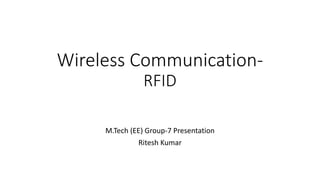Rfid interface with lpc2148
- 1. Wireless Communication- RFID M.Tech (EE) Group-7 Presentation Ritesh Kumar
- 2. RFID- Introduction • Radio Frequency Identification has found multiple applications right from Automatic Traffic Toll collection to Automated billing in Supermarkets. • Typical applications can be categorized as- • Access control and security • Tracking of products in Supply Chain • IDs of products at Point of Sale • Typical components of an RFID system include- • Active or Passive Tag • Tag reader • Communication unit • The frequency of operation usually falls in ISM band at 125 KHz, 13.56 MHz, 915 MHz or 2.4 GHz
- 3. RFID System Components • RFID Tag • Transponder • Located on the object • RFID Reader • Transceiver • Can read and write data to Tag • Data Processing Subsystem
- 4. Transponder • Consist of microchip that stores data and antenna • Active transponders have on-tag battery • Passive transponders obtain all power from the interrogation signal of reader • Active and passive only communicate when interrogate by transceiver
- 5. Transceiver • Consist of a RF module, a control unit, and a coupling element to interrogate tags via RF communication • Also have secondary interface to communicate with backend systems • Reads tags located in hostile environment and are obscured from view
- 6. Modulation • RF communications typically modulate high frequency carrier signal to transmit baseband code • Three classes of digital modulation are ASK, FSK, and PSK. • ASK most common in 13.56 MHz load modulation • PSK most common in 915 MHz backscatter modulation
- 7. Content
- 10. A typical Tag Reader board
- 11. P0.3 *P0.2 AD0.5 GND Vcc GND VIN CANL CANH P0.0-TxD0 P0.1-RxD0 AD0.0 AD0.1 AD0.2 AD0.3 XTAL1 62 XTAL2 61 P0.0/TxD0/PWM1 19 P0.1/RxD0/PWM3/EINT0 21 P0.2/SCL0/CAP0.0 22 P0.3/SDA0/MAT0..0/EINT1 26 P0.4/SCK0/CAP0.1/AD0.6 27 P0.5/MISO0/MAT0.1/AD0.7 29 P0.6/MOSI0/CAP0.2/AD1.0 30 P0.7/SSEL0/PWM2/EINT2 31 P0.8/TxD1/PWM4/AD1.1 33 P0.9/RxD1/PWM6/EINT3 34 P0.10/RTS1/CAP1.0/AD1.2 35 P0.11/CTS1/CAP1.1/SCL1 37 P0.12/DSR1/MAT1.0/AD1.3 38 P0.13/DTR1/MAT1.1/AD1.4 39 P0.14/DCD1/EINT1/SDA1 41 P0.15/RI1/EINT2/AD1.5 45 P0.16/EINT0/MAT0.2/CAP0.2 46 P0.17/CAP1.2/SCK1/MAT1.2 47 P0.18/CAP1.3/MISO1/MAT1.3 53 P0.19/MAT1.2/MOSI1/CAP1.2 54 P0.20/MAT1.3/SSEL1/EINT3 55 P0.21/PWM5/AD1.6/CAP1.3 1 P0.22/AD1.7/CAP0.0/MAT0.0 2 P0.23 58 P0.25/AD0.4/AOUT 9 P0.27/AD0.0/CAP0.1/MAT0.1 11 P0.28/AD0.1/CAP0.2/MAT0.2 13 P0.29/AD0.2/CAP0.3/MAT0.3 14 P0.30/AD0.3/EINT3/CAP0.0 15 V3 23 RST 57 VREF 63 VSS 6 VSSA 59 P1.16/TRACEPKT0 16 P1.17/TRACEPKT1 12 P1.18/TRACEPKT2 8 P1.19/TRACEPKT3 4 P1.20/TRACESYNC 48 P1.21/PIPESTAT0 44 P1.22/PIPESTAT1 40 P1.23/PIPESTAT2 36 P1.24/TRACECLK 32 P1.25/EXTIN0 28 P1.26/RTCK 24 P1.27/TDO 64 P1.28/TDI 60 P1.29/TCK 56 P1.30/TMS 52 P1.31/TRST 20 V3 43 V3 51 VSS 18 VSS 25 VSS 42 VSS 50 RTXC1 3 RTXC2 5 V3A 7 VBAT 49 P0.31 17 P0.26/AD0.5 10 U1 LPC2138 ARM7 Microcontroller (Note- CAN model not available in library) FUELCELL1 1.5V Represented by 1.5V Cell FUELCELL0 1.5V Represented by 1.5V cell R3 10k Voltage Divider R7 10k GND C1 1nF LPF RO 1 DE 3 DI 4 A 6 B 7 RE 2 U2 TJA1051- CAN TxRx R2 10k Voltage Divider R4 10k GND C2 1nF LPF FUELCELL3 1.5V Represented by 1.5V Cell FUELCELL2 1.5V Represented by 1.5V cell R1 10k Voltage Divider R5 10k GND C3 1nF LPF R6 10k Voltage Divider R8 10k GND C4 1nF LPF GND 27.0 3 1 VOUT 2 U3 LM35 Fuel Cell Temp Monitor C5 1nF Filter GND 1 2 J1 CONN-H2 PowerSupplyJack 12 X1 CRYSTAL Quartz C6 22pF Crystal Load Cap C7 22pF Crystal Load Cap GND R10 10k Reset Pull up C8 10nF Debouncing Cap GND SW1 SW-SPSTReset Switch L1Ferrite Bead 600R@100MHz Noise reduction in Analog GND C9 1nF Decoupling Cap / powerpin C10 1nF C11 1nF C12 1nF C13 1nF Decoupling GND VI 2 VO 3 GND 1 U4 79L05 LinearRegulatorD1 MZP4764A Reverse Polarity Protection C14 10nF ESD Protection C15 10u Buffer Cap C16 220nF Output Stability Cap Vcc Vcc 1 6 2 7 3 8 4 9 5 J2 CONN-D9M CAN CONN Vcc GND Vcc Xmodem, Ymodem, Zmodem VT52, VT100, ANSI RXD RTS TXD CTS HYPERTERMINAL 50% RV3 1k FuelCell1 71% RV1 1k FuelCell0 50% RV2 1k FuelCell2 50% RV4 1k FuelCell3 Vcc GND Actual AD0.0 Actual-AD0.1 Actual AD0.2 Actual AD0.3 AD0.0 AD0.1 AD0.2 AD0.3 System Schematic (tbc)












